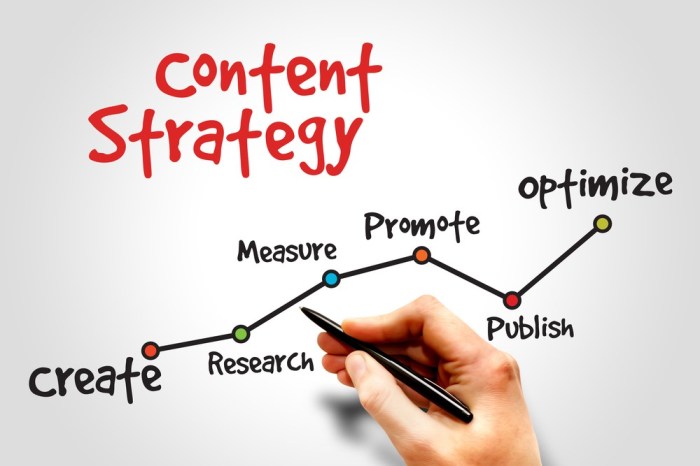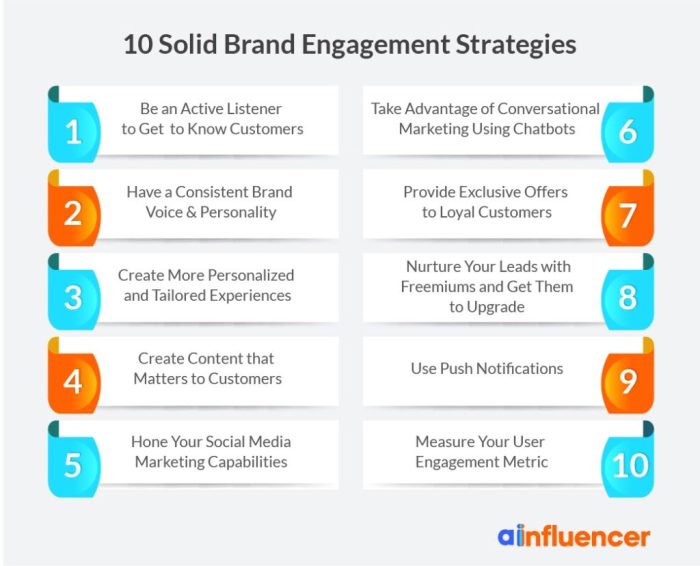Building a Content Strategy for Engagement takes center stage, inviting readers into a world of creativity and strategy. Get ready to dive deep into the art of captivating your audience!
As we delve further, you’ll uncover the secrets to creating compelling content that resonates with your audience and drives success.
Understanding Your Audience

To create a successful content strategy, you must first understand your audience. This involves identifying key demographics and psychographics to tailor your content specifically to their needs and preferences.
Identify Key Demographics and Psychographics
When identifying key demographics, you should consider factors such as age, gender, location, income level, education level, and more. Psychographics, on the other hand, delve into the interests, values, attitudes, and behaviors of your target audience.
- Demographics help you understand who your audience is, while psychographics help you understand why they do what they do.
- By combining both demographics and psychographics, you can create detailed buyer personas that represent your ideal customers.
Creating Buyer Personas
Buyer personas are fictional representations of your ideal customers based on real data and research. They help you understand your audience on a deeper level and create content that resonates with them.
Creating buyer personas allows you to personalize your content and address the specific needs and pain points of your audience.
Conducting Audience Research
To truly understand your audience, you need to conduct thorough audience research. This involves gathering data through surveys, interviews, social media analytics, website analytics, and more to uncover insights into their preferences and behaviors.
- Use tools like Google Analytics, Facebook Insights, and customer surveys to collect valuable data about your audience.
- Monitor social media interactions, comments, and feedback to gauge audience sentiment and engagement.
Defining Goals and Objectives
When it comes to building a killer content strategy, defining your goals and objectives is crucial. You need to have a clear idea of what you want to achieve with your content, whether it’s increasing engagement, driving conversions, or both. Setting specific goals will guide your content creation process and help you stay on track.
Setting Measurable Objectives
To track the success of your content strategy, it’s important to establish measurable objectives. These objectives should be quantifiable and specific, allowing you to monitor your progress and make adjustments as needed. Whether it’s increasing website traffic, growing your social media following, or boosting sales, having measurable objectives will help you gauge the effectiveness of your content efforts.
- Utilize tools like Google Analytics to track key metrics such as page views, bounce rate, and conversion rates.
- Set specific targets for each objective, such as increasing website traffic by 20% within the next quarter.
- Regularly review your progress against these objectives and adjust your content strategy accordingly.
Aligning Content Goals with Business Objectives
Your content goals should align with your overall business objectives to ensure that your efforts are contributing to the success of your company. Whether it’s increasing brand awareness, generating leads, or driving sales, your content strategy should support these broader goals.
Remember, your content should not only engage your audience but also drive them towards taking a desired action that aligns with your business objectives.
Content Planning and Ideation
When it comes to planning and generating content ideas that truly engage your audience, creativity is key. Brainstorming sessions can be a great way to come up with fresh and innovative concepts that will resonate with your target demographic. It’s important to think outside the box and consider different angles and perspectives to keep your content interesting and relevant.
Methods for Brainstorming Creative Ideas
- Host team brainstorming sessions to generate a variety of ideas
- Use mind mapping techniques to visually organize thoughts and concepts
- Review customer feedback and frequently asked questions for inspiration
- Stay updated on industry trends and competitor strategies for new insights
Significance of Creating a Content Calendar
Having a content calendar can help you stay organized and ensure that your content is consistently delivered to your audience. It allows you to plan ahead, schedule posts, and align your content with important dates, events, and promotions. By maintaining a content calendar, you can also track the performance of your content and make adjustments as needed to optimize engagement.
Tips for Aligning Content with the Buyer’s Journey, Building a Content Strategy for Engagement
Understanding the buyer’s journey is crucial for creating content that resonates with your audience at each stage of their purchasing decision.
- Identify the different stages of the buyer’s journey: awareness, consideration, decision
- Create content that addresses the needs and questions of your audience at each stage
- Utilize a mix of educational, informative, and promotional content to guide buyers through the journey
- Personalize content to cater to the specific interests and preferences of your target audience
Choosing the Right Channels: Building A Content Strategy For Engagement
When it comes to choosing the right channels for your content strategy, it’s essential to consider where your target audience spends their time online. By exploring different digital platforms and channels for content distribution, you can effectively reach and engage with your audience in a way that resonates with them.
Selecting Channels Based on Audience Preferences
To select the right channels based on audience preferences and behavior, you need to conduct thorough research to understand where your audience is most active. This could include social media platforms like Instagram, Twitter, or Facebook, as well as other channels like email newsletters, blogs, or video-sharing sites. By identifying where your audience likes to consume content, you can tailor your strategy to meet their preferences.
- Utilize analytics tools to track audience engagement on different channels.
- Survey your audience to gather insights on their preferred platforms.
- Monitor industry trends to stay updated on emerging channels.
Optimizing Content for Each Channel
Optimizing content for each specific channel is crucial to maximize engagement and reach. Each platform has its own unique requirements and best practices, so it’s important to tailor your content accordingly.
- Adapt the format and tone of your content to fit the platform (e.g., visual content for Instagram, short and snappy posts for Twitter).
- Use hashtags and s strategically to improve discoverability.
- Optimize images and videos for each platform’s specifications to ensure they display correctly.
Creating High-Quality Content
When it comes to crafting engaging and valuable content, there are a few best practices to keep in mind. First and foremost, always put your audience first. Understand what they want and need, and tailor your content to meet those expectations. Secondly, focus on providing value – whether it’s through education, entertainment, or inspiration, make sure your content serves a purpose.
Lastly, strive for authenticity and transparency in everything you create. Your audience will appreciate honesty and realness.
Using Storytelling, Visuals, and Interactive Elements
To enhance engagement, storytelling can be a powerful tool. By weaving narratives into your content, you can create a more emotional connection with your audience. Visuals, such as images, infographics, and videos, can also help make your content more engaging and memorable. Interactive elements, like quizzes, polls, and interactive graphics, can further increase engagement by encouraging participation and interaction.
- Use storytelling to create a narrative arc that captivates your audience and keeps them engaged from start to finish.
- Incorporate high-quality visuals that are relevant to your content and enhance the overall message you’re trying to convey.
- Add interactive elements to encourage audience participation and make your content more dynamic and engaging.
Maintaining Consistency and Authenticity
Consistency is key when it comes to content creation. Make sure your tone, style, and messaging remain consistent across all your content to build brand recognition and trust with your audience. Authenticity is equally important – be true to your brand and values, and don’t try to be something you’re not. Your audience can spot inauthenticity from a mile away, so always stay true to who you are.
- Develop a content style guide to ensure consistency in tone, voice, and visual elements.
- Regularly review and refine your content strategy to ensure it aligns with your brand values and resonates with your audience.
- Engage with your audience authentically by responding to comments, messages, and feedback in a genuine and transparent manner.
Measuring and Analyzing Results

When it comes to measuring and analyzing the results of your content strategy, there are several key metrics that you should track to understand how your content is performing and engaging with your audience. By keeping a close eye on these metrics, you can make informed decisions about what is working well and what may need to be adjusted.
Key Metrics to Track
- Website Traffic: Monitor the number of visitors to your website to see how your content is driving traffic.
- Engagement Metrics: Look at metrics like time spent on page, bounce rate, and social shares to gauge how engaged your audience is with your content.
- Conversion Rates: Measure how many visitors are taking desired actions on your website, such as signing up for a newsletter or making a purchase.
- Performance: Keep track of your search engine rankings and organic traffic to assess how well your content is optimized for search.
Tools and Methods for Analysis
- Google Analytics: Utilize this powerful tool to track and analyze website traffic, user behavior, and conversions.
- Social Media Analytics: Platforms like Facebook Insights and Twitter Analytics provide valuable data on engagement and audience demographics.
- A/B Testing: Experiment with different versions of your content to see which performs better and use the results to optimize future content.
Iterating and Optimizing Content
- Use data insights: Analyze the data collected from various metrics to identify trends and patterns that can help you improve your content strategy.
- Experiment with different formats: Test out different types of content to see what resonates best with your audience and adjust your strategy accordingly.
- Continuously monitor and adjust: Regularly review your analytics data and make ongoing adjustments to optimize your content for better engagement and results.